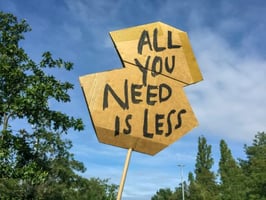By now, it’s no secret that online shopping has been popular for a number of years, but has seen...
Consume Less, Share Better.
Here at Faslet, one of our core values is Awareness; We accept our responsibility for the environment and inclusiveness, and therefore, it is our goal to make retailers and customers aware to operate more sustainably. This means finding solutions for the present, such as our size recommendation widget, while keeping the future generations in mind and making sure that they will be able to live a good life. Three main aspects are often cited when it comes to sustainability: environmental, social, and economical.
According to the circular economy, to which we fully adhere, we create more value through a model of production and consumption in which existing materials and products are recycled, refused, recovered, re-gifted, repaired, re-used, and reduced, for as long as possible

How can we ensure that we respect the 7Rs of the circular economy and work together towards a better future? Say no more, here are some examples: Fashion-edition
- Thrift Shop
More and more people are giving pre-loved items a second chance at life, as we all should!
We all know the typical thrift shop. A shop selling second-hand clothes and household goods, usually to raise funds for a charity. Even luxury brands re-sell vintage items, at lower prices, like Episode. Episode is all about sustainability. They wash, repair, and resell clothes for a bargain.
If you want to make a buck off this, you can share your wardrobe on Vinted. This platform is used the most to put your clothes up for sale. You don’t pay any shipping costs and the full amount goes straight into your pocket.
- Don’t just take, give!
If earning a penny is not your priority, then we would like to present to you the following sustainable, social and creative way to get rid of your clothes:The clothing exchange, pass-on-bag, chain-bag,…You can’t think of enough synonyms for it, but the goal remains the same: To give your clothes a second life. Everyone has items of clothing hanging in their closet that are in perfect condition but are hardly ever worn or the wrong size. What do you do with them? The clothing swaps! The pass-on-bag is the covid-proof version of the clothing swap party. The bag is passed around in a group of +/- 50 women (or men). If you have something hanging in your closet that you no longer wear, then you put it in the bag. If there is something in the bag that catches your eye, it’s yours! After that, it’s just a matter of passing the bag on to the next participant. Today, there are more than 250 chain groups in the Netherlands and about 8,000 participants. (source: Zootje geregeld, 2021)
The pass-on-bag is the covid-proof version of the clothing swap party. The bag is passed around in a group of +/- 50 women (or men). If you have something hanging in your closet that you no longer wear, then you put it in the bag. If there is something in the bag that catches your eye, it’s yours! After that, it’s just a matter of passing the bag on to the next participant. Today, there are more than 250 chain groups in the Netherlands and about 8,000 participants. (source: Zootje geregeld, 2021)
A perfect way of shopping for fashion lovers who strive for a more sustainable fashion environment, or slow fashion.
Slow Fashion Movement’s mission is to connect people locally and globally, so they can take collective action against the polluting fashion industry. It is also a creative way of getting to know new people. You could even say that the chain clothes swap has formed a real community. Is there no swap group in your area yet? Then you can set up a chain yourself! - Rent it out!
Now we’ve mainly talked about second-hand selling and giving, but there are other solutions too. Rent it out! Litchy, for example, is an Amsterdam-based clothing rental shop. Lizzy Perridon opened its doors in 2019 after running into shopping problems herself. You see a designer dress, which is so cool, but you don’t buy it because you will probably only wear it once. “I want to spend my money on nice basics, but extravagant designer dresses, I just want to be able to rent.” Lizzy said in an interview with Elle. Renting clothes is not only more sustainable, but also cheaper. Especially when it comes to designer dresses. While we know that sustainable clothing brands are doing their very best to push the fashion industry in the right direction, good sustainable quality and ethical production are unfortunately just a bit pricier. Therefore, a cheaper way of sustainable shopping is to reuse what others have! Did you know that with these small sustainable-fashion steps, you’re already making a massive difference?
Did you know that with these small sustainable-fashion steps, you’re already making a massive difference?




